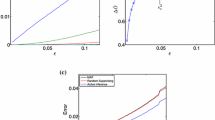Abstract
In a hidden Markov model, the underlying Markov chain is usually unobserved. Often, the state path with maximum posterior probability (Viterbi path) is used as its estimate. Although having the biggest posterior probability, the Viterbi path can behave very atypically by passing states of low marginal posterior probability. To avoid such situations, the Viterbi path can be modified to bypass such states. In this article, an iterative procedure for improving the Viterbi path in such a way is proposed and studied. The iterative approach is compared with a simple batch approach where a number of states with low probability are all replaced at the same time. It can be seen that the iterative way of adjusting the Viterbi state path is more efficient and it has several advantages over the batch approach. The same iterative algorithm for improving the Viterbi path can be used when it is possible to reveal some hidden states and estimating the unobserved state sequence can be considered as an active learning task. The batch approach as well as the iterative approach are based on classification probabilities of the Viterbi path. Classification probabilities play an important role in determining a suitable value for the threshold parameter used in both algorithms. Therefore, properties of classification probabilities under different conditions on the model parameters are studied.
Similar content being viewed by others
References
Bahl LR, Cocke J, Jelinek F, Raviv J (1974) Optimal decoding of linear codes for minimizing symbol error rate (Corresp.) IEEE Trans Inf Theory 20(2):284–287
Brejová B, Brown DG, Vinař T (2007) The most probable annotation problem in HMMs and its application to bioinformatics. J Comput Syst Sci 73(7):1060–1077
Brushe GD, Mahony RE, Moore JB (1998) A soft output hybrid algorithm for ML/MAP sequence estimation. IEEE Trans Inf Theory 44(7):3129–3134
Cao L, Chen CW (2003) A novel product coding and recurrent alternate decoding scheme for image transmission over noisy channels. IEEE Trans Commun 51(9):1426–1431
Cappé O, Moulines E, Rydén T (2005) Inference in hidden Markov models. Springer, New York
Colella S, Yau C, Taylor JM, Mirza G, Butler H et al (2007) QuantiSNP: an objective Bayes Hidden-Markov Model to detect and accurately map copy number variation using SNP genotyping data. Nucl Acids Res 35(6):2013–2025
Doob JL (1953) Stochastic processes. Wiley, New York
Durbin R, Eddy SR, Krogh A, Mitchison G (1998) Biological sequence analysis: probabilistic models of proteins and nucleic acids. Cambridge University Press, Cambridge
Ephraim Y, Merhav N (2002) Hidden Markov processes. IEEE Trans Inf Theory 48(6):1518–1569
Gerencsér L, Molnár-Sáska G (2002) A new method for the analysis of hidden Markov model estimates. In: Proceedings of the 15th IFAC world congress, Barcelona, Spain
Hayes JF, Cover TM, Riera JB (1982) Optimal sequence detection and optimal symbol-by-symbol detection: similar algorithms. IEEE Trans Commun 30(1):152–157
Jelinek F (1997) Statistical methods for speech recognition. The MIT Press, Cambridge
Koloydenko A, Lember J (2008) Infinite Viterbi alignments in the two state hidden Markov models. Acta Comment Univ Tartu Math 12:109–124
Koski T (2001) Hidden Markov models for bioinformatics, volume 2 of computational biology series. Kluwer Academic Publishers, Dordrecht
Kuljus K, Lember J (2012) Asymptotic risks of Viterbi segmentation. Stoch Process Appl 122(9):3312–3341
Le Gland F, Mevel L (2000) Exponential forgetting and geometric ergodicity in hidden Markov models. Math. Control Signals Systems 13(1):63–93
Lember J (2011a) A correction on approximation of smoothing probabilities for hidden Markov models. Stat Probab Lett 81(9):1463–1464
Lember J (2011b) On approximation of smoothing probabilities for hidden Markov models. Stat Probab Lett 81(2):310–316
Lember J, Koloydenko A (2008) The adjusted Viterbi training for hidden Markov models. Bernoulli 14(1):180–206
Lember J, Koloydenko A (2010) A constructive proof of the existence of Viterbi processes. IEEE Trans Inf Theory 56(4):2017–2033
Lember J, Koloydenko A (2014) Bridging Viterbi and posterior decoding: a generalized risk approach to hidden path inference based on hidden Markov models. J Mach Learn Res 15 :1–58
Lember J, Kuljus K, Koloydenko A (2011) Theory of segmentation. In: Dymarsky P (ed) Hidden Markov models, theory and applications. InTech, pp 51–84
Li J, Gray RM, Olshen RA (2000) Multiresolution image classification by hierarchical modeling with two-dimensional hidden Markov models. IEEE Trans Inform Theory 46(5):1826–1841
Och FJ, Ney H (2000) Improved statistical alignment models. In: Proc 38th ann meet assoc comput linguist, pp 440–447
Rabiner LR (1989) A tutorial on hidden Markov models and selected applications in speech recognition. Proc IEEE 77(2):257–286
Rue H (1995) New loss functions in Bayesian imaging. J Am Stat Assoc 90 (431):900–908
Sznitman R, Jedynak B (2010) Active testing for face detection and localization. IEEE Trans Pattern Anal Mach Intell 32(10):1914–1920
Udupa RU, Maji HK (2005) Theory of alignment generators and applications to statistical machine translation. In: Kaelbling LP, Saffiotti A (eds) Proceedings of the 19th international joint conference on artificial intelligence (IJCAI-05), Edinburgh, Scotland, pp 1142–1147
Viterbi AJ (1967) Error bounds for convolutional codes and an asymptotically optimum decoding algorithm. IEEE Trans Inf Theory 13(2):260–269
Wang K, Li M, Hadley D, Liu R, Glessner J et al (2007) PennCNV: an integrated hidden Markov model designed for high-resolution copy number variation detection in whole-genome SNP genotyping data. Genome Res 17:1665–1674
Winkler G (2003) Image analysis, random fields and Markov Chain Monte Carlo methods, volume 27 of stochastic modelling and applied probability. Springer, Berlin
Yau C, Holmes CC (2013) A decision-theoretic approach for segmental classification. Ann Appl Stat 7(3):1814–1835
Author information
Authors and Affiliations
Corresponding author
Rights and permissions
About this article
Cite this article
Kuljus, K., Lember, J. On the Accuracy of the MAP Inference in HMMs. Methodol Comput Appl Probab 18, 597–627 (2016). https://doi.org/10.1007/s11009-015-9443-x
Received:
Revised:
Accepted:
Published:
Issue Date:
DOI: https://doi.org/10.1007/s11009-015-9443-x




